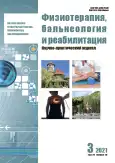Отдалённые результаты немедикаментозного лечения пациентов с рубцовыми изменениями кожи на фоне метаболического синдрома
- Авторы: Казанцева К.В.1, Фролков В.К.2, Нагорнев С.Н.2, Гусакова Е.В.3, Нагорнева М.С.4
-
Учреждения:
- Клиника эстетической медицины «Скин Арт»
- Центр стратегического планирования и управления медико-биологическими рисками здоровью
- Центральная государственная медицинская академия Управления делами Президента Российской Федерации
- Первый Московский государственный медицинский университет имени И.М. Сеченова (Сеченовский Университет)
- Выпуск: Том 20, № 3 (2021)
- Страницы: 199-207
- Раздел: Оригинальные исследования
- URL: https://journals.rcsi.science/1681-3456/article/view/106151
- DOI: https://doi.org/10.17816/1681-3456-2021-20-199-207
- ID: 106151
Цитировать
Аннотация
Обоснование. Эффективность физиотерапевтического лечения рубцовых изменений кожи снижается у пациентов с нарушением обмена углеводов и липидов. Для коррекции метаболических реакций предлагается применение питьевых минеральных вод, однако отдалённые результаты этой технологии не изучены.
Цель исследования ― изучение отдалённых результатов лечения пациентов с рубцовыми изменениями кожи после применения фототермолиза, ультрафонофореза ферменкола и внутреннего приёма минеральной воды с учётом наличия или отсутствия метаболического синдрома.
Материал и методы. Под нашим наблюдением находилось 120 пациентов с рубцовыми изменениями кожи, 60 из них с метаболическим синдромом. Пациенты методом случайного отбора были разделены на 2 группы ― с наличием и без метаболического синдрома, каждая из которых дополнительно подразделялась на 2 подгруппы по методу лечения: в первой — стандартная терапия, фракционный фототермолиз, ультрафонофорез ферменкола, во второй — аналогичный комплекс, дополненный внутренним приёмом минеральной воды «Ессентуки № 17». У всех пациентов определяли глюкозу крови, инсулин, индекс массы тела, малоновый диальдегид.
Результаты. Установлено, что у пациентов с метаболическим синдромом длительность сохранения достигнутых лечебных эффектов снижается уже через 6 мес наблюдений, тогда как на фоне приёма минеральной воды этот период удлиняется на 3–4 мес. Дополнительный к физиотерапевтическому лечению курс минеральной воды эффективно корригирует метаболические реакции и способствует снижению инсулинорезистентности.
Заключение. Применение питьевых минеральных вод, которые обладают выраженным активирующим влиянием на инсулиновую регуляцию метаболических реакций за счёт снижения резистентности к этому гормону, позволяет сохранить благоприятные изменения в обмене веществ и энергии в течение как минимум полугода, что способствует закреплению терапевтических эффектов комплексной физиотерапии и в определённой степени обладает профилактическим потенциалом.
Полный текст
Открыть статью на сайте журналаОб авторах
Кристина Вадимовна Казанцева
Клиника эстетической медицины «Скин Арт»
Email: fvk49@mail.ru
ORCID iD: 0000-0002-2473-3204
SPIN-код: 3088-6715
Россия, Москва
Валерий Константинович Фролков
Центр стратегического планирования и управления медико-биологическими рисками здоровью
Автор, ответственный за переписку.
Email: fvk49@mail.ru
ORCID iD: 0000-0002-1277-5183
SPIN-код: 3183-0883
д.б.н., профессор
Россия, МоскваСергей Николаевич Нагорнев
Центр стратегического планирования и управления медико-биологическими рисками здоровью
Email: fvk49@mail.ru
ORCID iD: 0000-0002-1190-1440
SPIN-код: 2099-3854
д.м.н., профессор
Россия, МоскваЕлена Викторовна Гусакова
Центральная государственная медицинская академия Управления делами Президента Российской Федерации
Email: fvk49@mail.ru
ORCID iD: 0000-0003-3254-0354
SPIN-код: 5913-9674
д.м.н.
Россия, МоскваМария Сергеевна Нагорнева
Первый Московский государственный медицинский университет имени И.М. Сеченова (Сеченовский Университет)
Email: fvk49@mail.ru
ORCID iD: 0000-0002-0940-7179
Россия, Москва
Список литературы
- Гуллер А.Е. Структурная композиция рубцов кожи человека // Х Всероссийская научно-практическая конференция «Молодые ученые в медицине». Казань, 2005. С. 217–218.
- Ильин М.В. Сочетанное применение ультрафонофореза протеолитических коллагеназ и методики фракционного фототермолиза в коррекции рубцовых изменений кожи: Автореф. дис. … канд. мед. наук. Москва, 2014. 24 с.
- Казанцева К.В., Нагорнев С.Н., Фролков В.К. Физиотерапия рубцовых изменений кожи в условиях метаболического синдрома // Физиотерапевт. 2020. № 6. С. 15–21. doi: 10.33920/med-14-2012-02
- Талыбова А.П., Стенько А.Г. Эффективность комбинированного применения неодимового (1064 нм) лазера и фракционного фототермолиза в коррекции гормонально-зависимых атрофических рубцов // Физиотерапия, бальнеология и реабилитация. 2017. Т. 16, № 4. С. 177–181. doi: 10.18821/1681-3456-2017-16-3-177-181
- Карпова Т.Н., Пономаренко Г.Н., Самцов А.В. Электро- и ультрафонофорез коллагеназы в коррекции рубцов кожи // Вестник Российской военно-медицинской академии. 2009. № 1. С. 89–93.
- Фролков В.К., Нагорнев С.Н., Корлякова О.В. Некоторые итоги изучения механизмов действия питьевых минеральных вод и перспективы дальнейшего развития этой проблемы // Физиотерапия, бальнеология и реабилитация. 2020. Т. 19, № 1. С. 51–58. doi: 10.18821/10.17816/1681-3456-2020-19-1-9
- Park Т.Н., Seo S.W., Kim J.K., Chang C.H. Management of chest keloids // J Cardiothoracic Surg. 2011. Vol. 6, № 1. P. 49. doi: 10.1186/1749-8090-6-49
- Robles D.T., Berg D. Abnormal wound healing: keloids // Clin Dermatol. 2007. Vol. 25, № 1. P. 26–32. doi: 10.1016/j.clindermatol.2006.09.009
- Urioste S.S., Arndt K.A., Dover J.S. Keloids and hypertrophic scars: review and treatment strategies // Semin Cutan Med Surg. 1999. Vol. 18, № 2. P. 159–171. doi: 10.1016/s1085-5629(99)80040-6
- Cruz-Korchin N.I. Effectiveness of silicone sheets in the prevention of hypertrophic breast scars // Ann Plast Surg. 1996. Vol. 37, № 4. P. 345–348. doi: 10.1097/00000637-199610000-00001
- Перловская В.В., Стальмахович В.Н. Рубцовые поражения кожи у детей // Сибирский медицинский журнал. 2009. Т. 90, № 7. С. 240–244.
- Rusciani L., Paradisi A., Alfanoetal C. Cryotherapy in the treatment of keloids // J Drugs Dermatol. 2006. Vol. 5, № 7. P. 591–595.
- Гаврилов В.Б., Гаврилова А.Р., Мажуль Л.М. Анализ методов определения продуктов ПОЛ в сыворотке по тесту с ТБК // Вопросы медицинской химии. 1987. № 1. С. 118–122.
- Полушина Н.Д., Фролков В.К., Ботвинева Л.А. Превентивная курортология (теоретические и прикладные аспекты, перспективы). Пятигорск, 1997. 225 с.
Дополнительные файлы








